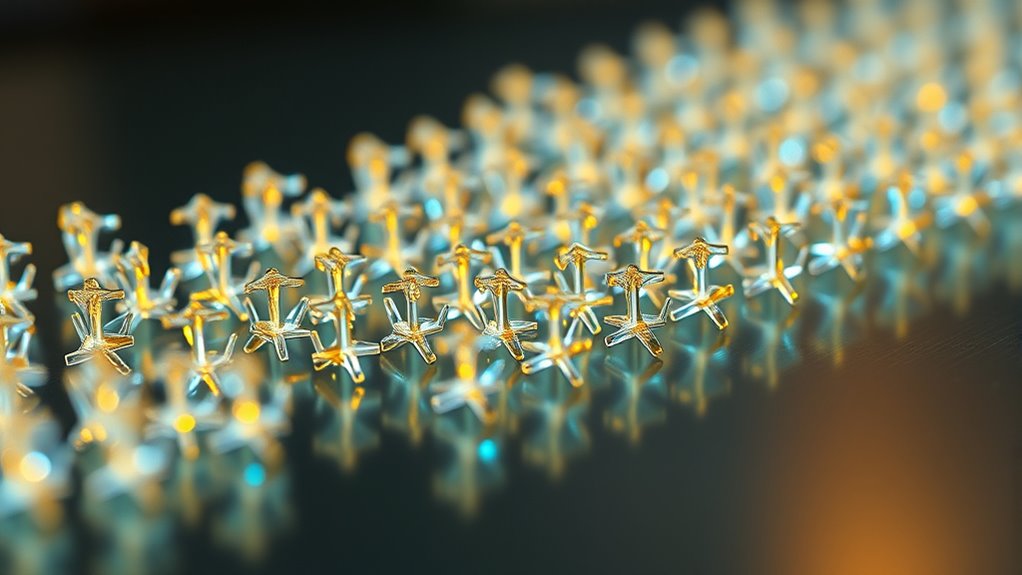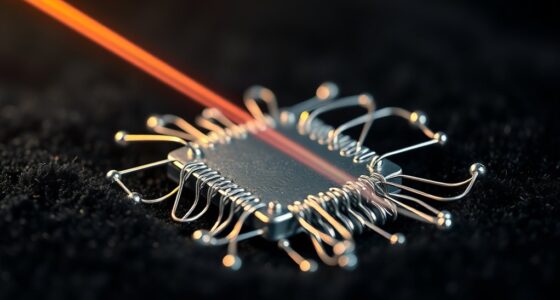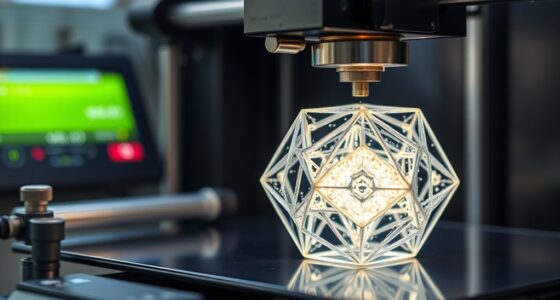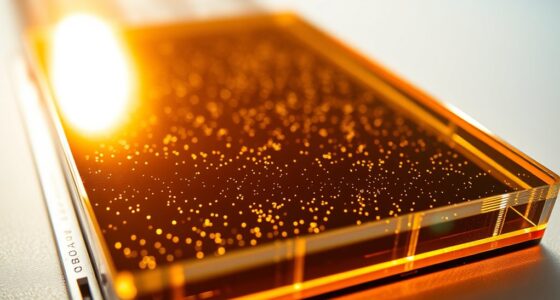Piezoelectric nanomaterials are tiny materials that generate electrical signals when you apply mechanical stress. Their small size and high surface area make them highly sensitive, perfect for energy harvesting and sensing applications. You can use them to power small devices, wearable health monitors, or environmental sensors, enabling self-powered systems. As you explore further, you’ll discover how advances in fabrication and device design are revealing their full potential for future smart technologies.
Key Takeaways
- Piezoelectric nanomaterials generate electrical signals in response to mechanical stress, enabling nanoscale energy harvesting and sensing.
- Their small size and high surface area enhance sensitivity, efficiency, and performance in energy conversion applications.
- They are integrated into wearable devices, sensors, and systems for real-time, high-precision detection and energy generation.
- Advances in nanofabrication enable flexible, robust, and multifunctional piezoelectric nanodevices tailored for specific needs.
- These nanomaterials are key to developing self-powered, miniaturized systems for smart technology, health monitoring, and environmental sensing.

Piezoelectric nanomaterials are tiny structures that generate electrical signals when subjected to mechanical stress. Their small size and unique properties make them ideal for nanoscale energy harvesting applications, where you can convert mechanical vibrations into usable electrical energy. This capability opens the door for powering small devices without relying on traditional batteries, making systems more sustainable and maintenance-free. When integrated into nanoscale energy harvesting devices, these nanomaterials can efficiently capture energy from everyday mechanical movements—like vibrations, body motions, or even ambient environmental forces. As you explore their potential, you’ll find that their high surface area-to-volume ratio enhances their sensitivity and energy conversion efficiency, which is critical for practical, real-world applications.
Incorporating piezoelectric nanomaterials into sensors is a game-changer for nanotechnology. Their ability to generate an electrical response upon mechanical deformation allows for seamless piezoelectric sensor integration into various systems. Imagine embedding these sensors into wearable health monitors, where they detect subtle movements or physiological signals and convert them directly into electrical signals for processing. Because of their nanoscale dimensions, these sensors can be integrated into compact, lightweight devices that don’t compromise comfort or design. Plus, their high responsiveness means you get real-time data with high precision, essential for applications like structural health monitoring or environmental sensing.
Furthermore, the integration process is streamlined thanks to advances in nanofabrication techniques. You can design flexible, robust, and highly sensitive piezoelectric nanodevices that work reliably under different mechanical stresses. This flexibility allows for the development of multifunctional systems where energy harvesting and sensing happen simultaneously, reducing the need for separate components. As you leverage nanoscale energy harvesting, you maximize the efficiency of your devices, making them more autonomous and sustainable. These nanomaterials can be tailored to specific needs by adjusting their composition or structure, offering versatility in diverse fields—from biomedical devices to smart infrastructure. Additionally, a key feature of piezoelectric nanomaterials is their high surface area-to-volume ratio, which enhances their overall performance and sensitivity in practical applications.
Ultimately, piezoelectric nanomaterials serve as the backbone of innovative solutions that harness mechanical energy at the smallest scales. Their synergy with nanoscale energy harvesting and sensor integration enables you to develop smarter, more efficient systems. Whether you’re working on wearable tech, environmental sensors, or self-powered devices, understanding how to utilize these nanomaterials will give you a significant edge in advancing next-generation technologies. Their potential to transform how we generate and use energy at the microscopic level is vast, promising a future where energy efficiency and miniaturization go hand in hand.
Frequently Asked Questions
How Do Environmental Factors Affect Piezoelectric Nanomaterials?
Environmental factors like humidity, temperature fluctuations, and pollution can considerably impact piezoelectric nanomaterials. You might find that environmental degradation leads to reduced material stability, causing the nanomaterials to lose their piezoelectric properties over time. Exposure to moisture or extreme temperatures accelerates deterioration, affecting device performance. To guarantee longevity, you should consider protective coatings or controlled environments, minimizing the impact of these environmental factors on your nanomaterials.
What Are the Latest Advancements in Nanomaterial Manufacturing?
You’re exploring the latest in nanomaterial manufacturing, where innovations in synthesis techniques lead the way. Researchers now focus on scalable methods that enable mass production without sacrificing quality, combining precision with efficiency. Advances like green synthesis, 3D printing, and roll-to-roll processes revolutionize how materials are created, ensuring you can develop high-performance nanomaterials suitable for diverse applications. These breakthroughs make it possible for you to turn cutting-edge research into real-world solutions faster than ever.
Are There Health Risks Associated With Nanomaterial Exposure?
You should be aware that nanomaterial exposure can pose health risks, raising nanotoxicology concerns. As you handle or work with nanomaterials, it’s important to conduct thorough health risk assessments to understand potential impacts. These assessments help identify possible toxicity or environmental effects, so you can implement proper safety measures. Staying informed about emerging research guarantees you’re prepared to minimize health risks associated with nanomaterials.
How Do Piezoelectric Properties Vary With Nanomaterial Size?
You might notice that as nanomaterial size decreases, their piezoelectric properties change due to size-dependent effects like quantum confinement. Smaller particles often exhibit enhanced or altered piezoelectric responses because their reduced dimensions influence electron behavior and polarization. This size dependence means you can tailor these properties for specific applications, but it also requires careful control during synthesis to guarantee consistent performance. So, nanomaterial size plays a vital role in their piezoelectric characteristics.
What Future Applications Are Being Explored Beyond Current Uses?
You can expect future applications of piezoelectric nanomaterials to expand into wearable sensors and energy harvesting devices. Researchers are exploring how these materials can create flexible, lightweight sensors that monitor health metrics in real-time. Additionally, they’re developing efficient energy harvesters that convert mechanical movements into electrical power, powering small devices sustainably. This innovation could revolutionize healthcare, wearable tech, and sustainable energy solutions, making them more integrated, efficient, and versatile.
Conclusion
Just as a tiny spark ignites a mighty flame, your exploration of piezoelectric nanomaterials reveals their transformative power. These nanoscale crystals symbolize potential—vibrations turning into energy, chaos into order. Embrace their silent song, where every deformation echoes innovation, and each application becomes a beacon guiding future technologies. In their delicate structure lies the promise of a brighter, more responsive world, reminding you that small changes can resonate with profound impact.







